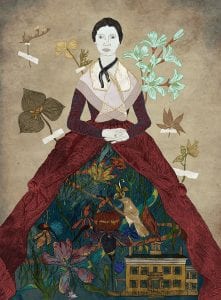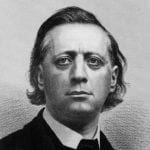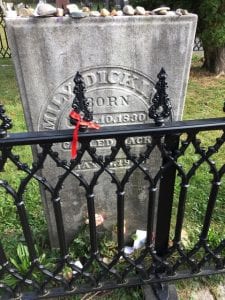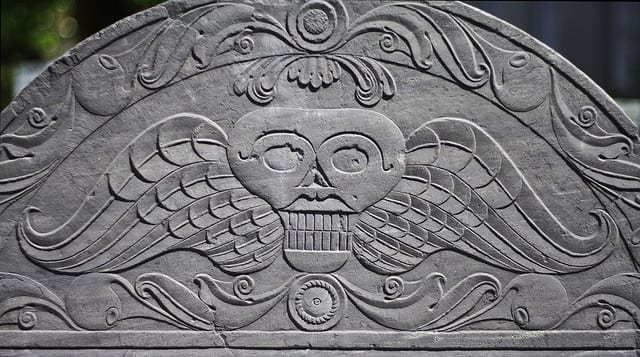
In our time, November 11 is Veterans Day, an official holiday first known as Armistice Day, which marked the end of World War I. In 1954, it was renamed as a day to honor all the people in the United States Armed Forces, a day to remember those who served and especially those who died. It thus seems a fitting week to explore Emily Dickinson’s many startling poems about death, written during a time of war. We also have a special guest respondent, Iraqi poet and translator of Dickinson, Naseer Hassan, who has lived under the shadow of war and death for many years and finds consolation in Dickinson's words.
Dickinson wrote about death all through her life but many of her masterpieces cluster in the period of 1861-63, when the nation itself struggled to come to terms with the awful, mounting death toll of the war. Critics and readers agree that some of Dickinson’s greatest poems touch on death and the questions it raises: what is it and why is it? what does it feel like to die? how should we regard death? and especially, what happens after death?
Death touched Dickinson early in her life and frequently thereafter, affecting her deeply. Wendy Martin calculates that 31 of her friends and family died from tuberculosis during her lifetime. But she was not alone or idiosyncratic in her preoccupation. Puritan tradition had a long history of focusing on “making a good death,” and sentimental Victorian culture was obsessed with all the trappings of death, the stages of dying, the rituals of the deathbed and burial. This obsession was fed but also profoundly disrupted by the unprecedented carnage caused by the Civil War, as Drew Gilpin Faust demonstrates in her powerful study, The Republic of Suffering: Death and the American Civil War. This week, we explore how Dickinson borrows, adapts, and often subverts many of her culture’s attitudes and formulas in her wide-ranging and often surprising treatments of death.
“The Night is Murk, and the Stars are Dim”
The Springfield Republican, November 8, 1862
Progress of the War, page 1
“The advance of the army of McClellan into Virginia goes on steadily and with a good degree of speed. But the news from the front is so limited, from motive of obvious military prudence, that we know only a part of what has been accomplished and can only conjecture the plan of the campaign. Gen. McClellan seems to be endeavoring to close all avenues of escape against the enemy, and it is believed at Washington that he is conducting the campaign with great sagacity and energy, and that he will win a great success without any such terrible sacrifice of life as has attended most of our battles in Virginia.” [Editor's Note: McClellan’s caution and failure to act would soon drive President Lincoln to relieve him of his command.]
Foreign Affairs, page 1
“The resignations [of M. Thouvenel, the French minister of foreign affairs, and M. Fould, the minister of finance] indicate a decided change in the policy of France toward Italy, and it is regarded as certain that the French will not evacuate Rome. The emperor of the French has lately become very pious, and all France looks on in amazement at the sudden ascendancy of the priests’ party.” [see The Second Italian War of Independence]
Souls Misplaced, page 6
“Mrs. Kirkland [Caroline Mathilda Stansbury Kirkland (1801-1864), an American writer] writing of those men and women who seem to have got each other’s attributes—the men having the softness of woman, the woman the roughness of man, said, ‘In these cases the natural body has only to be laid aside by its decease for the spirit to assert its latent sexuality; so that many a woman who has gone to sleep on this side of Jordan in short gown and petticoat, will wake up by mere spiritual gravitation on the other side in corduroys and top boots; and many a man who has lain down in coat and pantaloons, will in like manner come to his true self-consciousness in petticoat and curl papers!’”
Wit and Wisdom, page 7
“A drop of the blackest ink may diffuse a light as brilliant as the light of day.”

Books, Authors and Arts, page 7
“The pleasant newspaper essays with which Henry Ward Beecher [1813-1887] has amused his own lighter moments and those of his friends during the last few years, have been gathered into a comely little volume with the somewhat repulsive title of Eyes and Ears. Let no one turn away from the work as a treatise on special anatomy. The myriad-minded pastor refers to eyes that see ‘the light that never was on sea or shore,’ besides a great deal that adds beauty and interest to both; to ears that catch the melodies in which ‘the morning stars sang together, and all the sons of God shouted for joy.’”
Hampshire Gazette, November 11, 1862
Amherst, page 3
“Monuments and gravestones have been defaced in the burying ground in Amherst, by certain evil-minded persons who have not the fear of the law before their eyes.”
Harper’s Monthly, November 1862

Buying Winter Things, page 803 [by Louise Chandler Moulton (1835-1908), an American poet, story-writer and critic]
“I have not realized the fact of suffering as I realize it now. It is the hour of darkness all over the land. The resurrection morning will come by-and-by, but now the night is murk, and the stars are dim. I have given more to my country than gold could buy. One I loved, and who loved me, went, in August, with the three-years’ men [men who enlisted for three years and often received a bounty]. He came to me with the light of eager courage and self-devotion in his eyes, and asked me to bid him God-Speed, and send him on his mission. Yes, I gave him up. He is gone. He will come again, perhaps; but I can never forget that other perhaps—that the mouth which kissed mine at parting may never kiss again, and the eyes at whose courage I lit the fire of my own resolve may look their last on the smoky sky of some Southern battle-ground.”
“Dying is a Wild Night and a New Road”
“Even in an age fascinated by [death’s] every manifestation and trapping,” according to Judith Farr, Dickinson “showed exceptional curiosity about death.” Curiosity, indeed. In several letters throughout her life, Dickinson wrote to observers at the death beds of loved ones asking, “Was he/she willing to die,” since “making a good death” in the Puritan religious tradition gave some indication that one was predestined for salvation (see, for example, L153 to Edward Everett Hale on the death of her father’s law clerk and her poetic mentor Benjamin F. Newton).
But the deaths of loved ones decimated Dickinson. When she was fourteen, her close friend Sophia Holland, “with whom my thoughts & her own were the same,” died. This loss affected her profoundly. Two years later, on March 28, 1846, she wrote about this death to her new friend Abiah Root:
I visited her often in sickness & watched over her bed. But at length Reason fled and the physician forbid any but the nurse to go into her room. Then it seemed to me I should die too if I could not be permitted to watch over her or even to look at her face. At length the doctor said she must die & allowed me to look at her a moment through the open door. I took off my shoes and stole softly to the sick room.
There she lay mild & beautiful as in health & her pale features lit up with an unearthly—smile. I looked as long as friends would permit & when they told me I must look no longer I let them lead me away. I shed no tear, for my heart was too full to weep, but after she was laid in her coffin & I felt I could not call her back again I gave way to a fixed melancholy.
I told no one the cause of my grief, though it was gnawing at my very heart strings. I was not well & I went to Boston & stayed a month & my health improved so that my spirits were better. I trust she is now in heaven & though I shall never forget her, yet I shall meet her in heaven (L11).
As Farr notes, this early letter “contains some expressions common to sentimental Victorian death scenes,” but its suffering is real. Almost forty year later, the death of Susan and Austin’s third child, eight year old Thomas Gilbert, nicknamed Gib, from typhoid fever in October 1883 devastated the family and caused Dickinson to have a breakdown from which she never recovered.

Joan Kirkby outlines the larger cultural context for Dickinson’s attitudes. She notes that the 19th century experienced a “crisis of death” in which the new sciences and Enlightenment thinking severed death from its theological moorings, producing what theorist Roland Barthes calls “flat death,” demise without the assurance of an afterlife. People struggled with the notion of a “desacralized death” that thinkers, scientists and writers strove to explain.
At Amherst Academy in the 1840s, for example, Dickinson would have studied physician John Abercrombie’s Inquiries Concerning the Intellectual Powers (1849), which declared:
our whole experience is opposed to the belief that one atom which ever existed has ceased to exist.
In the 1850s, Thomas Wentworth Higginson gave a series of lectures on spiritualism, a movement that had become wildly popular. These lectures were printed as a tract titled “The Results of Spiritualism” and reported in the Springfield Republican on March 21, 1859. In the tract, he concluded optimistically,
the principal results of the new phenomena, are the demonstrations of immortality and the removal of the fear of death and the terrors of theology.
Then, in the 1860s, the Civil War caused unforeseen and unprecedented death tolls. Drew Gilpin Faust explains that the number of the war’s fatalities, totaling about 620,000,
is approximately equal to the total American fatalities in the Revolution, the War of 1812, the Mexican War, the Spanish-American War, World War I, World War II, and the Korean War combined. … The Civil War produced carnage that has often been thought reserved for the combination of technological proficiency and inhumanity characteristic of a later time.
And that did not include civilians, women and children caught in the crossfire and chaos. Everyone was touched by the devastation.
One notable aspect of Dickinson’s “curiosity” about death was how it overlapped with her experience of love and passion, with the emotions of life in the body and in nature. In 1869, she wrote to console her cousin Perez Cowan on a loss and describes death in terms that echo one of her greatest erotic poems:
It grieves me that you speak of Death with so much expectation. I know there is no pang like that for those we love, nor any leisure like the one they leave so closed behind them, but Dying is a wild Night and a new Road.
I suppose we are all thinking of Immortality, at times so stimulated that we cannot sleep. Secrets are interesting, but they are also solemn – and speculate with all our might, we cannot ascertain. (L332)
 Dickinson planned out her own funeral down to the last details, requesting that her coffin be carried out the backdoor of the Homestead (not out the formal front door to a waiting, feather-bedecked, horse-drawn hearse, as was customary for people of her status) by six Irishmen who worked for her family, that they circle her flower garden, walk through the barn behind the house and down a grassy path across house lots and fields to West Cemetery and the family plot. For more details, See “Emily Dickinson and Death.”
Dickinson planned out her own funeral down to the last details, requesting that her coffin be carried out the backdoor of the Homestead (not out the formal front door to a waiting, feather-bedecked, horse-drawn hearse, as was customary for people of her status) by six Irishmen who worked for her family, that they circle her flower garden, walk through the barn behind the house and down a grassy path across house lots and fields to West Cemetery and the family plot. For more details, See “Emily Dickinson and Death.”
Reflection
Naseer Hassan
 A small story with Emily Dickinson
A small story with Emily Dickinson
My attention to Dickinson’s poetry started with reading a translation of some of her poems in a chapter of Archibald MacLeish’s Poetry and Experience (1961). That was in the 1990s. I felt then, ambiguously, that there was something mysterious and exceptional in those translated poems, but I felt simultaneously that the translation couldn’t grasp the precious essence of them.
This motivated me to search and find Dickinson’s poems in the English versions, which was not easy at that time, due to the many restrictions and obstacles on books and publishing under the Iraqi dictatorship, where I lived. I could later find a couple of books that included some of her poems. And the unique mixture of psychological introspection, the contemplative air of questions about death, fear, hope, and time—all this in short pieces urged me to try translating these small beautiful sculptures, to see how they would look in Arabic.
In those years I could only translate a few poems and published only 3; several I didn’t publish. The hard circumstances of living, the heavy censorship under the dictatorship, as well as some personal life difficulties made me not only stop translating more of Dickinson’s poems, but stop writing and publishing my own poems for long years too.
My “projects” revived about a decade ago and completing a book of Dickinson’s poems was a major one. And, so it was that Emily Dickinson: Selected Poems and Critical Articles was published first in Baghdad in 2009, then in Beirut in 2012. It included 51 selected poems and some critical articles on her poetry, to make it easier for the Arabic reader to approach this sort of unique, unfamiliar poetry.
 In the past, there was perhaps only one book on Dickinson’s poetry in Arabic, as well as some translations of her poetry in magazines and periodicals. This reflects the profound cultural crisis in the Arab world, which affects many areas including the translation of foreign works into Arabic (and the statistics showing few translations of international works demonstrate this.) And as far as I know, my translation of Dickinson’s poetry is the first one in the current century, at least.
In the past, there was perhaps only one book on Dickinson’s poetry in Arabic, as well as some translations of her poetry in magazines and periodicals. This reflects the profound cultural crisis in the Arab world, which affects many areas including the translation of foreign works into Arabic (and the statistics showing few translations of international works demonstrate this.) And as far as I know, my translation of Dickinson’s poetry is the first one in the current century, at least.
In the translation process, I faced exceptional difficulties. This kind of poetry, with its allusions, personifications, and interference of different levels in an integrated artistic context, needs special contemplation and an ability to “touch” the internal unity inside the rich variety. Without this, the hope of a successful translation will be in vain. Dickinson’s poems are almost like living tiny creatures, very sensible and rich, so the challenges of translation are naturally greater.
One of the important merits of great literature is that it can exceed limits of time and space. And Dickinson’s poetry has this merit; readers can see in its mirror the reflections of their own lives and contemplations, in spite of the huge distance in time and space from where the poems were born. Because we, Iraqis, passed through very hard conditions in the last decades—wars and destruction—questions about life, death, fear, hope, and the meaning of existence became more essential. All these elements exist in Dickinson’s poetry, so there is a sort of “spiritual kinship” with such poetry.
I love many of Dickinson’s poems, maybe most of all: “Because I could not stop for Death” and “I died for beauty,” which were two of the earliest poems I translated. Many questions and scenes that we pass through in our daily life make me go back to or remember this or that line of Dickinson’s poetry, and feel it again in a new way. For example, because our life in Iraq is almost like a continuous hurricane (with short intervals of peace), this makes it important to know how to restart again and again. And between each new start and another, there are spaces to stop and contemplate words like:
After great pain, a formal feeling comes
The nerves sit ceremonious, like tombs.
[Editor's note: Many thanks to poet Naomi Shihab Nye, who brought Naseer's wonderful work to my attention and helped me make contact with him.]
bio: Naseer HASSAN is an Iraqi poet and translator of poetry and philosophy. He was born in Baghdad in 1962 and graduated with a degree in architecture from Baghdad University. He is a member of the Iraqi Writers Union and the Iraqi Journalists Guild and has published four poetry collections in Arabic: [The Circle of Sundial] (1998), [Suggested Signs] (2007), [Being Here] (2008), and [Dayplaces] (2010). Hassan's collected poems appeared in 2010 from the Arabic Publishing House in Beirut. He has translated into Arabic three books of poetry and one of philosophy: [Emily Dickinson: Selected Poems and Critical Readings] (the first book on Emily Dickinson in Arabic); [Luis Borges: 60 Selected Poems]; [Days of the Shore: Selections from the New American Poetry 1980-2010]; and [Asian Philosophies by John Koller]. In addition, he has several poetic and philosophical translations forthcoming, including [Kierkegaard: A Brief Introduction], [Schopenhauer's The World as Will and Representation (Book 1)], and [House of the Star: Poems from Robert Frost, Wallace Stevens, Langston Hughes].
Sources
Overview
Faust, Drew Gilpin. The Republic of Suffering: Death and the American Civil War. New York: Alfred A. Knopf, 2008.
Martin, Wendy. The Cambridge Companion to Emily Dickinson. Cambridge: Cambridge University Press, 2007, 22.
History
Hampshire Gazette, November 11, 1862
Harper's Monthly, November 1862
Springfield Republican, November 8, 1862
Biography
Farr, Judith. The Passion of Emily Dickinson. Cambridge: Harvard University Press. 1992, 4-5.
Faust, Drew Gilpin. “Preface.” The Republic of Suffering: Death and the American Civil War. New York: Alfred A. Knopf, 2008.
Kirkby Joan. “Death and Immortality.” Emily Dickinson in Context. Ed. Eliza Richards. New York: Cambridge University Press, 2013, 160-168.
St. Armand, Barton Levi. Emily Dickinson and Her Culture: The Soul’s Society. Cambridge: Cambridge University Press, 1984, 5.




